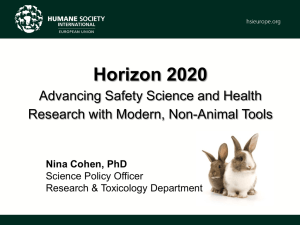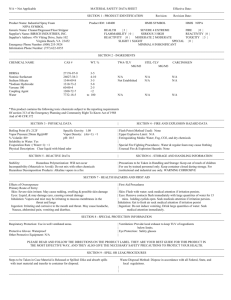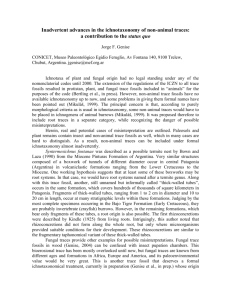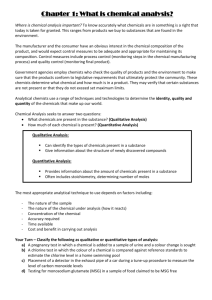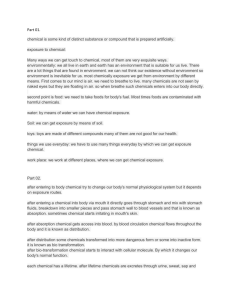Environmental Protection Agency, Ariel Rios Building
advertisement
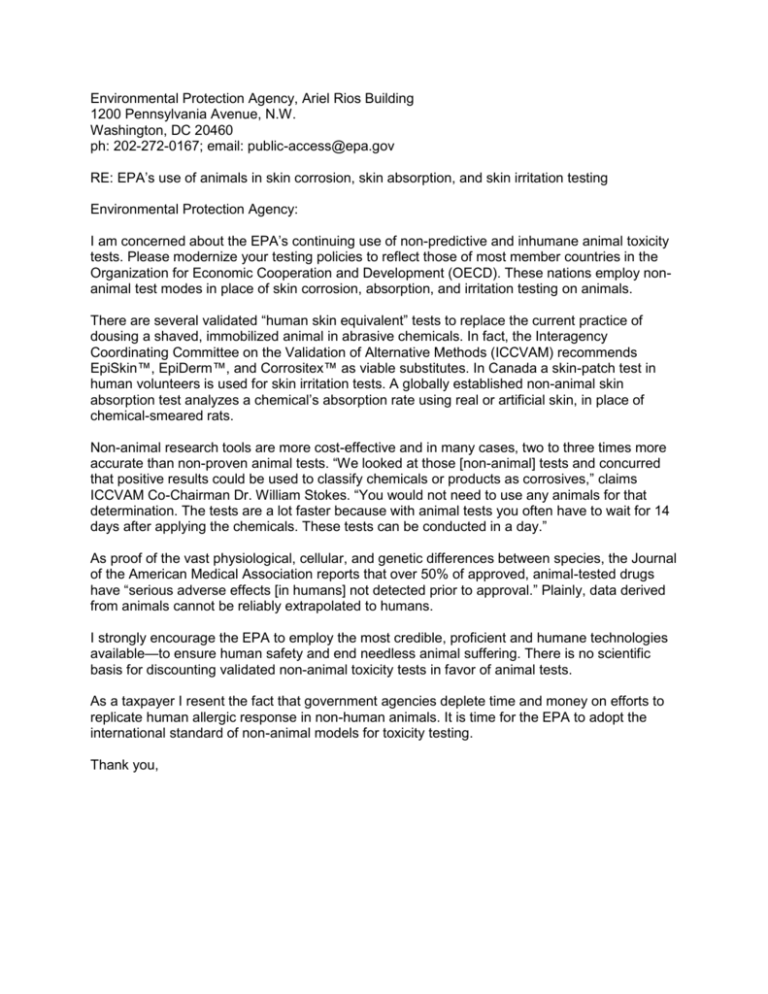
Environmental Protection Agency, Ariel Rios Building 1200 Pennsylvania Avenue, N.W. Washington, DC 20460 ph: 202-272-0167; email: public-access@epa.gov RE: EPA’s use of animals in skin corrosion, skin absorption, and skin irritation testing Environmental Protection Agency: I am concerned about the EPA’s continuing use of non-predictive and inhumane animal toxicity tests. Please modernize your testing policies to reflect those of most member countries in the Organization for Economic Cooperation and Development (OECD). These nations employ nonanimal test modes in place of skin corrosion, absorption, and irritation testing on animals. There are several validated “human skin equivalent” tests to replace the current practice of dousing a shaved, immobilized animal in abrasive chemicals. In fact, the Interagency Coordinating Committee on the Validation of Alternative Methods (ICCVAM) recommends EpiSkin™, EpiDerm™, and Corrositex™ as viable substitutes. In Canada a skin-patch test in human volunteers is used for skin irritation tests. A globally established non-animal skin absorption test analyzes a chemical’s absorption rate using real or artificial skin, in place of chemical-smeared rats. Non-animal research tools are more cost-effective and in many cases, two to three times more accurate than non-proven animal tests. “We looked at those [non-animal] tests and concurred that positive results could be used to classify chemicals or products as corrosives,” claims ICCVAM Co-Chairman Dr. William Stokes. “You would not need to use any animals for that determination. The tests are a lot faster because with animal tests you often have to wait for 14 days after applying the chemicals. These tests can be conducted in a day.” As proof of the vast physiological, cellular, and genetic differences between species, the Journal of the American Medical Association reports that over 50% of approved, animal-tested drugs have “serious adverse effects [in humans] not detected prior to approval.” Plainly, data derived from animals cannot be reliably extrapolated to humans. I strongly encourage the EPA to employ the most credible, proficient and humane technologies available—to ensure human safety and end needless animal suffering. There is no scientific basis for discounting validated non-animal toxicity tests in favor of animal tests. As a taxpayer I resent the fact that government agencies deplete time and money on efforts to replicate human allergic response in non-human animals. It is time for the EPA to adopt the international standard of non-animal models for toxicity testing. Thank you, U. S. Food and Drug Administration 5600 Fishers Lane Rockville MD 20857-0001 ph: 1-888-INFO-FDA (1-888-463-6332) online comments: http://www.fda.gov/comments.html RE: Food and Drug Administration’s use of animals in skin absorption, skin irritation, phototoxicity and pyrogenicity testing U.S. Food and Drug Administration: I am concerned about the FDA’s continuing use of non-predictive animal toxicity tests. Please modernize your testing policies to reflect those of most member countries in the Organization for Economic Cooperation and Development (OECD). These nations employ non-animal test modes in place of skin absorption, skin irritation, phototoxicity and pyrogenicity testing on animals. There are several validated “human skin equivalent” tests to replace the current practice of dousing a shaved, immobilized animal in abrasive chemicals. In fact, the Interagency Coordinating Committee on the Validation of Alternative Methods (ICCVAM) recommends EpiSkin™, EpiDerm™, and Corrositex™ as viable substitutes. In Canada a skin-patch test in human volunteers is used for skin irritation tests. A globally established non-animal skin absorption test analyzes a chemical’s absorption rate using real or artificial skin in place of chemical-smeared rats. The 3T3 NRU Phototoxicity Test can replace the application of chemicals to shaved skin patches on restrained animals, half of whom undergo ultra violet radiation exposure, before all are killed. Alternatives such as the in vitro pyrogen test can supplant pyrogenicity tests in which body-restrained rabbits injected with test matter are monitored for fever and inflammation while enduring respiratory, circulatory or organ failure. Non-animal research tools are more cost-effective and in many cases, two to three times more accurate than non-proven animal tests. With regard to skin corrosivity and irritation tests, ICCVAM Co-Chairman Dr. William Stokes states: “You would not need to use any animals for that determination. [Non-animal tests] are a lot faster because with animal tests you often have to wait for 14 days after applying the chemicals. These tests can be conducted in a day.” As proof of the vast physiological, cellular, and genetic differences between species, the Journal of the American Medical Association reports that over 50% of approved, animal-tested drugs have “serious adverse effects [in humans] not detected prior to approval.” Plainly, data derived from animals cannot be reliably extrapolated to humans. I strongly encourage the FDA to employ the most credible, proficient and humane technologies available—to ensure human safety and end needless animal suffering. As a taxpayer I resent the fact that government agencies deplete time and money on efforts to replicate human allergic response in non-human animals. It is time for the FDA to adopt the international standard of non-animal models for toxicity testing. Thank you, U.S. Department of Transportation 400 7th Street, S.W. Washington, D.C. 20590 email: dot.comments@ost.dot.gov RE: Department of Transportation’s use of animals in skin corrosion testing U.S. Department of Transportation: I am concerned about DOT’s continuing use of non-predictive, misleading and inhumane animal toxicity tests. Please modernize your testing policies to reflect those of most member countries in the Organization for Economic Cooperation and Development (OECD). These nations employ non-animal test modes in place of skin irritant testing on rabbits and other animals. There are several validated “human skin equivalent” tests to replace the current practice of dousing a shaved, immobilized animal in abrasive chemicals that can burn skin until tissue and bone are exposed. In fact, the Interagency Coordinating Committee on the Validation of Alternative Methods (ICCVAM) recommends EpiSkin™ (cells cultivated into 3-D tissue to simulate human skin); EpiDerm™ (another human skin cell model); and Corrositex™ (a protein membrane formulated to act like human skin) as viable substitutes for corrosion testing on animals. Non-animal research tools are more cost-effective and in many cases, two to three times more accurate than non-proven animal tests. “We looked at those [non-animal] tests and concurred that positive results could be used to classify chemicals or products as corrosives,” claims ICCVAM Co-Chairman Dr. William Stokes. “You would not need to use any animals. The tests are a lot faster because with animal tests you often have to wait for 14 days after applying the chemicals. These tests can be conducted in a day.” As proof of the vast physiological, cellular, and genetic differences between species, the Journal of the American Medical Association reports that over 50% of approved, animal-tested drugs have “serious adverse effects [in humans] not detected prior to approval.” Plainly, data derived from animals cannot be reliably extrapolated to humans. I strongly encourage DOT to employ the most credible, proficient and humane technologies available—to ensure human safety and end needless animal suffering. There is no scientific basis for discounting validated non-animal toxicity tests in favor of animal tests. As a taxpayer I resent the fact that government agencies deplete time and money on efforts to replicate human allergic response in non-human animals. It is time for DOT to adopt the international standard of non-animal models for toxicity testing. Thank you, Occupational Safety & Health Administration 200 Constitution Avenue, NW Washington, DC 20210 RE: Occupational Safety & Health Administration’s use of animals in skin absorption testing Occupational Safety & Health Administration: I am concerned about OSHA’s continuing use of non-predictive and inhumane animal toxicity tests. Please modernize your testing policies to reflect those of most member countries in the Organization for Economic Cooperation and Development (OECD). These nations employ nonanimal test modes in place of skin absorption testing on animals. There are viable substitutes for the current practice of smearing the shaved backs of rodents with chemicals for 24 hours, after which the animals are stored in metabolism cages to collect their waste for evaluation. One globally established non-animal skin absorption test calibrates the rate at which a test chemical passes into and across real or artificial skin to a fluid reservoir. The receptor fluid and treated skin are analyzed to learn how a substance is absorbed. Non-animal research tools are more cost-effective and in many cases, two to three times more accurate than non-proven animal tests. With regard to skin corrosivity and irritation tests, ICCVAM Co-Chairman Dr. William Stokes states: “You would not need to use any animals for that determination. [Non-animal tests] are a lot faster because with animal tests you often have to wait for 14 days after applying the chemicals. These tests can be conducted in a day.” As proof of the vast physiological, cellular, and genetic differences between species, the Journal of the American Medical Association reports that over 50% of approved, animal-tested drugs have “serious adverse effects [in humans] not detected prior to approval.” Plainly, data derived from animals cannot be reliably extrapolated to humans. I strongly encourage OSHA to employ the most credible, proficient and humane technologies available—to ensure human safety and end needless animal suffering. There is no scientific basis for discounting validated non-animal toxicity tests in favor of animal tests. As a taxpayer I resent the fact that government agencies deplete time and money on efforts to replicate human allergic response in non-human animals. It is time for OSHA to adopt the international standard of non-animal models for toxicity testing. Thank you, U.S. Consumer Product Safety Commission Washington, D.C. 20207-0001 ph: 301-504-6816; fax: 301-504-0124 and 301-504-0025 email: info@cpsc.gov RE: Consumer Product Safety Commission use of animals in skin irritation testing Consumer Product Safety Commission: I am concerned about CPSC’s continuing use of non-predictive and inhumane animal toxicity tests. Please modernize your testing policies to reflect those of most member countries in the Organization for Economic Cooperation and Development (OECD). These nations employ nonanimal test modes in place of skin irritant testing on rabbits and other animals. There are several validated “human skin equivalent” tests to replace the current practice of dousing a shaved, immobilized animal in abrasive chemicals. In fact, the Interagency Coordinating Committee on the Validation of Alternative Methods (ICCVAM) recommends EpiSkin™, EpiDerm™, and Corrositex™ as viable substitutes for corrosion testing on animals. In Canada a skin-patch test in human volunteers is used for skin irritation tests. Before administering patches to people, scientists screen for corrosivity via non-animal modes, computer modeling and in vitro tests. Non-animal research tools are more cost-effective and in many cases, two to three times more accurate than non-proven animal tests. “We looked at those [non-animal] tests and concurred that positive results could be used to classify chemicals or products as corrosives,” claims ICCVAM Co-Chairman Dr. William Stokes. “You would not need to use any animals for that determination. The tests are a lot faster because with animal tests you often have to wait for 14 days after applying the chemicals. These tests can be conducted in a day.” As proof of the vast physiological, cellular, and genetic differences between species, the Journal of the American Medical Association reports that over 50% of approved, animal-tested drugs have “serious adverse effects [in humans] not detected prior to approval.” Plainly, data derived from animals cannot be reliably extrapolated to humans. I strongly encourage CPSC to employ the most credible, proficient and humane technologies available—to ensure human safety and end needless animal suffering. There is no scientific basis for discounting validated non-animal toxicity tests in favor of animal tests. As a taxpayer I resent the fact that government agencies deplete time and money on efforts to replicate human allergic response in non-human animals. It is time for CPSC to adopt the international standard of non-animal models for product safety testing. Thank you, ATSDR Information Center Mailstop E-29, 1600 Clifton Rd. Atlanta, GA 30333 U.S.A. toll-free ph: 1-888-42-ATSDR or 1-888-422-8737; fax: 404-498-0093 online comments: http://www.atsdr.cdc.gov/contactus.html RE: Agency for Toxic Substances and Disease Registry’s use of animals in skin absorption testing ATSDR Information Center: I am concerned about ATSDR’s continuing use of non-predictive and inhumane animal toxicity tests. Please modernize your testing policies to reflect those of most member countries in the Organization for Economic Cooperation and Development (OECD). These nations employ nonanimal test modes in place of skin absorption testing on animals. There are viable substitutes for the current practice of smearing the shaved backs of rodents with chemicals for 24 hours, after which the animals are stored in metabolism cages to collect their waste for evaluation. One globally established non-animal skin absorption test calibrates the rate at which a test chemical passes into and across real or artificial skin to a fluid reservoir. The receptor fluid and treated skin are analyzed to learn how a substance is absorbed. Non-animal research tools are more cost-effective and in many cases, two to three times more accurate than non-proven animal tests. With regard to skin corrosivity and irritation tests, ICCVAM Co-Chairman Dr. William Stokes states: “You would not need to use any animals for that determination. [Non-animal tests] are a lot faster because with animal tests you often have to wait for 14 days after applying the chemicals. These tests can be conducted in a day.” As proof of the vast physiological, cellular, and genetic differences between species, the Journal of the American Medical Association reports that over 50% of approved, animal-tested drugs have “serious adverse effects [in humans] not detected prior to approval.” Plainly, data derived from animals cannot be reliably extrapolated to humans. I strongly encourage ATSDR to employ the most credible, proficient and humane technologies available—to ensure human safety and end needless animal suffering. There is no scientific basis for discounting validated non-animal toxicity tests in favor of animal tests. As a taxpayer I resent the fact that government agencies deplete time and money on efforts to replicate human allergic response in non-human animals. It is time for ATSDR to adopt the international standard of non-animal models for toxicity testing. Thank you, The Honorable Representative U.S. House of Representatives Washington, D.C. 20510 The Honorable Senators The U.S. Senate, U.S. Capitol Building Washington, D.C. 20510 Dear Representative _________________________________________ Dear Senators ______________________________________________ I call upon my elected officials to urge government agencies to phase-out misleading and inhumane animal toxicity tests. Please advise the Environmental Protection Agency, Food and Drug Administration, Department of Transportation, Occupational Safety and Health Administration, Consumer Product Safety Commission and Agency for Toxic Substances and Disease Registry to modernize their testing policies. Are you aware that the majority of member countries in the Organization for Economic Cooperation and Development (OECD) employ non-animal test modes in place of skin corrosion, skin irritation, skin absorption, phototoxicity and pyrogenicity testing on animals? As a taxpayer I resent the fact that U.S. agencies still deplete time and money on futile efforts to replicate human allergic response in non-human animals. Data derived from animals cannot be reliably extrapolated to humans. There are several validated “human skin equivalent” tests to replace the current practice of dousing a shaved, immobilized animal in abrasive chemicals. In fact, the Interagency Coordinating Committee on the Validation of Alternative Methods (ICCVAM) recommends EpiSkin™, EpiDerm™, and Corrositex™ as viable substitutes. In Canada a skin-patch test in human volunteers is used for skin irritation tests. A globally established non-animal skin absorption test analyzes a chemical’s absorption rate using real or artificial skin in place of chemical-smeared rats. The 3T3 NRU Phototoxicity Test can replace the application of chemicals to shaved skin patches on restrained animals, half of whom undergo ultra violet radiation exposure, before all are killed. Alternatives such as the in vitro pyrogen test can supplant pyrogenicity tests in which body-restrained rabbits injected with test matter are monitored for fever and inflammation while enduring respiratory, circulatory or organ failure. Non-animal research tools are more cost-effective and in many cases, two to three times more accurate than non-proven animal tests. With regard to skin corrosivity and irritation tests, ICCVAM Co-Chairman Dr. William Stokes states: “You would not need to use any animals for that determination. With animal tests you often have to wait for 14 days after applying the chemicals. [Non-animal tests] tests can be conducted in a day.” It is time for the U.S. to adopt the international standard of non-animal models for toxicity testing. Thank you,
